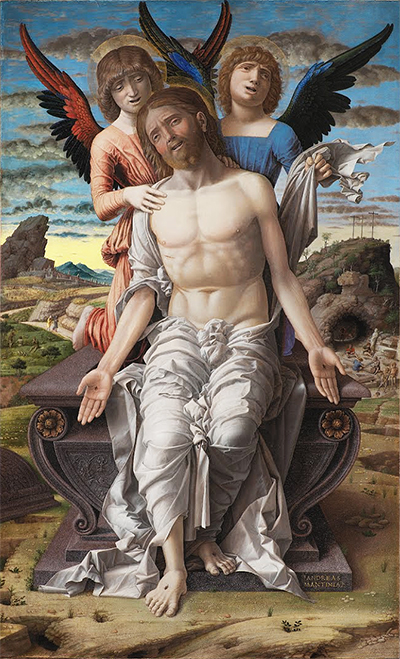 Buy Art Prints Now
Buy Art Prints Nowfrom Amazon
* As an Amazon Associate, and partner with Google Adsense and Ezoic, I earn from qualifying purchases.
Discover the life and career of Andrea Mantegna in this detailed biography.
Andrea Mantegna was born on 13 September 1431, in Isola di Carturo, the Republic of Venice, which is close to Padua (now called Italy). He was an Italian painter and a student of Roman archaeology plus Jacopo Bellini's son-in-law and brother-in-law to Giovanni.
Like other artists of his time, Andrea experimented with perspective; for instance, by lowering the horizon to create a sense of higher monumentality. Andrea's flinty, metallic landscapes and to some degree stony figures give evince to an approach to painting that was fundamentally sculptural. Also, before 1500, he led a workshop, which was leading in Venice in the production of prints.
Youth and Education
At eleven years old, Andrea became the apprentice of Francesco Squarcione, a Paduan painter. Francesco, who was originally a tailor by profession, seems to have had an enthusiasm for ancient art plus a talent for acting. Like his celebrated compatriot Petrarca, Francesco had an enthusiasm for ancient Rome.
He travelled to Greece and Italy collecting vases, reliefs, antique statues, and more; he made drawings from them. He then made his collections available for others to study. During this entire time, he was undertaking works on commission, and his pupils contributed to those works.
Andrea's early career was typically shaped by the ideas of Florentine works. During this time, Andrea was Francesco's favourite pupil, who taught him Latin and also instructed him to study Roman sculpture fragments. Also, the master preferred forced perspective, which accounts some of Andrea's later innovations.
At the age of 17, however, Andrea left Francesco's workshop. Later, he claimed Francesco was profiting from his work without giving him sufficient payment.
Andrea Mantegna's work
Andrea's first work, which is now lost, was the 1448 altarpiece for Santa Sofia Church. The same year, Nicolò Pizolo and Andrea were called to work together with a group of painters who were entrusted to decorate Ovetari Chapel, a chapel in the transept of Church of the Hermits. However, it is probable that before that time, some of Francesco's pupils, including Andrea, had already started frescoes series in the chapel of San Cristoforo, in Sant'Agostino degli Eremitani church, now considered a masterpiece.
Andrea finished most of the work by himself after some coincidences, although Ansuino, who worked jointly with Andrea in the Ovetari Chapel project, brought his technique from the Forlivese school of art. The series was almost completely lost in the allied bombings that took place in Padua in 1944. The most dramatic fresco cycle work was the one set in a lowered viewpoint (worm's-eye view perspective), Andrea's St. James on his Way to Execution.
Another example where the artist used worm's-eye view perspective is seen in his painting Saints Peter and Paul. Although it's less dramatic in its view when compared to the St. James painting, the San Zeno altarpiece triptych was about 1455, not so long after the cycle of St. James was completed, and it uses similar techniques. This includes an architectural structure that was based on Classical antiquity.
One of the first Mantegna frescoes are the 2 saints found at the entrance porch of Sant'Antonio church in Padua, and also a 1453 San Luca Altarpiece, with St. Luke plus other saints for S. Giustina church, now in the Milan-based Brera Gallery. As he progressed in his work, Andrea was influenced by Jacopo Bellini, who was the father of the famous painters Gentile Bellini and Giovanni Bellini, and he met Nicolosia, his daughter. Jacopo Bellini consented to the marriage between Andrea and Nicolosia.
St. Stephen fresco sketch survived, and it's the earliest preliminary sketch still surviving to compare with the comparable fresco. The picture gives evidence that nude figures (later drawn as clothed) were being used in the creation of works done during the Early Renaissance period. In the preliminary sketch, however, the perspective is much less developed plus it's closer to an average viewpoint.
Despite the authentic monument Classical look, it isn't a copy of any recognised Roman structure. Also, Andrea adopted the wet drapery Romans designs, who took this pattern from the Greek invention earlier, for his figures' clothing, although the interactions and tense figures are derived from Donatello.
Later years of Mantegna
Despite his declining health, Andrea continued painting. Other works of that period include Lamentation of Christ, the St. Sebastian and the 1488-1490 Madonna of the Caves. Another work of Andrea's later years was the 1496 Madonna della Vittoria, which is now in the world's largest art museum, Louvre.




